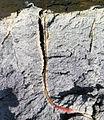Lugworm
| Lugworm | ||||||||||||
|---|---|---|---|---|---|---|---|---|---|---|---|---|

Lugworm |
||||||||||||
| Systematics | ||||||||||||
|
||||||||||||
| Scientific name | ||||||||||||
| Arenicola marina | ||||||||||||
| Linnaeus , 1758 |
The lugworm ( Arenicola marina ), also called (sand) pierworm or troughworm , belongs to a group of stuck and burrowing lines within the annelid worms , which are called sedentaria . Due to its way of life in the sand of the tidal flats , it is an important part of the ecosystem of the Wadden Sea in the east of the Atlantic Ocean . It is one of the most famous animals of the tidal flats, which is due in particular to its characteristic piles of faeces that appear omnipresent in the tidal flats.
features
The red-brown worm becomes about 20 to 40 cm long and the front half is about a finger thick. The back end is thinner because that's where only the intestines are . All other organs (reproduction, etc.) and also the external gills are located in the front section. Lugworms weigh around 40–50 grams.
distribution
The lugworm Arenicola marina is widespread in the wadden seas of the eastern Atlantic region, namely in the wadden sea of the North Sea . In the wadden seas of the western Atlantic (North America) it is represented by the species Arenicola cristata . It is one of the few species that colonize the entire mudflat from the low to the high water line, but prefers unstable sand mudflats.
Lifestyle and diet
The larvae of the lugworm move to the surface of the soil when there are fewer predators in autumn than in summer. Up to a size of six millimeters, they settle in horizontal tubes just below the surface in areas of the mud flats and spend the winter there. Next July they dig vertical tubes just below the flood line and spend the time there until autumn.
Before winter, the animals move into the range of the adult animals. There the adult digs its 20–30 cm deep U-shaped tubes in the Wadden Sea. It constantly eats the sand of the mudflats and filters out the organic matter, which it then uses. Furthermore, it remains mobile and thus contributes to the destabilization and upheaval of the tidal flats. The lugworms of the North Sea eat the entire sand of the mudflat above 20 cm depth once a year. This is due to the fact that the animals occur in an average density of 40 specimens per square meter. A single lugworm filters 25 kg of sand a year.
Every 30 to 40 minutes the lugworm comes to the exit of its tube and expels the consumed sand, which marks the exit area of its tube as a spaghetti-shaped pile of sand (worm pile). The entrance area is marked with a hole on the surface, which can be seen as a small depression in the Wadden Sea at low tide. This area is called the "feeding funnel". There it picks up the nutrient-rich sand in order to utilize it. Coarse particles are not eaten, but deposited at the head end. This creates a layer of coarser material at a depth of 20 to 25 centimeters.
Reproduction
The lugworm is sexually mature after two years. The reproduction takes place during the phase of the full moon in the month of October by the male his semen discharges into the water. When the sperm reaches the living tube of a female, the female releases the eggs into the water. The female keeps the fertilized eggs in its tube until the larvae have hatched. Then the young swim in the open water. They settle in the fine substrate for the winter; only in the following year do they float onto the sand plates, the habitat of the adult lugworms.
Predators
When the tide is low , birds adapted to life in the tidal flats, such as the oystercatcher , the knutt or the dunlin, run across the tidal flats. These bird species are characterized by their long legs and pointed, long beaks. As soon as a new worm pile emerges from the ground, the birds poke their beaks into the tube and try to grab the worm. To avoid being eaten whole, the lugworm can shed its thin rear end piece by piece. The bird then only gets one to two centimeters to eat and the worm can escape into the depths of its burrow.
See also
The lugworm is one of the Wadden Sea's Small Five .
A long, thin sausage is named after the lugworm .
literature
- ER Trueman: The Mechanism of Burrowing in the Polychaete Worm Arenicola marina (L.) . In: The Biological Bulletin , 131, Marine Biological Laboratory, Woods Hole 1966, pp. 369-377 ( biolbull.org English; PDF; 1.1 MB).
- W. Westheide, G. Rieger: Special zoology, part 1: unicellular and invertebrate animals. 3. Edition. Springer-Verlag, Berlin / Heidelberg 2013.
Web links
Individual evidence
- ^ A b c Karl-Heinz van Bernem: Distribution of macrofauna species in the Wadden Sea . In: Federal Environment Agency and national park administrations of Lower Saxony Wadden Sea / Schleswig-Holstein Wadden Sea (ed.): Wadden Sea Environment Atlas . Vol. 1: North Frisian and Dithmarsches Wadden Sea . Eugen Ulmer, Stuttgart 1998/1999, ISBN 3-8001-3491-8 , pp. 94-95.



